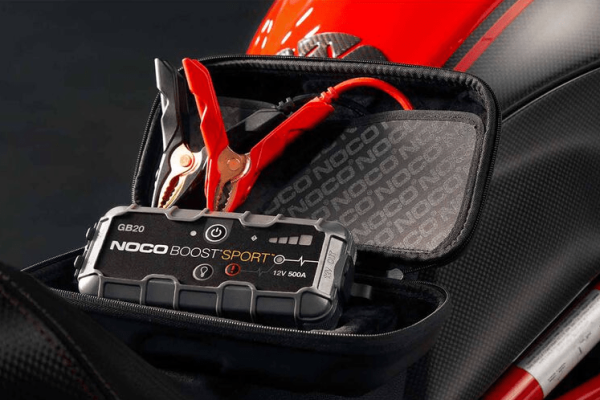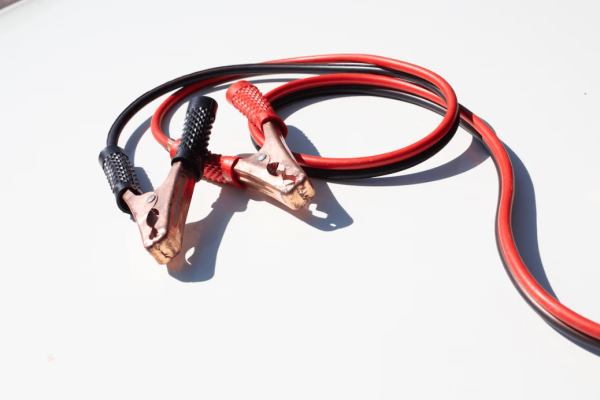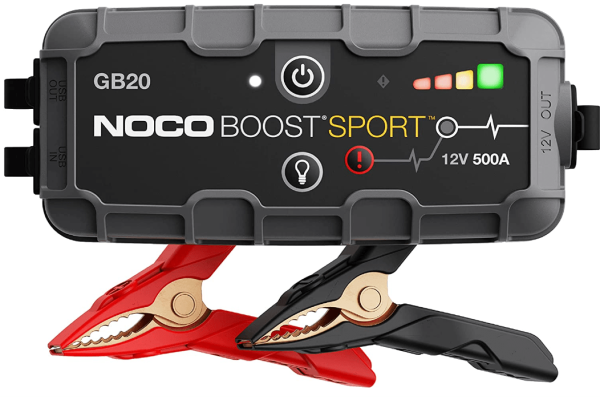Whether stranded at the side of the road or awakening your bike from its winter slumber, a dead battery is a frustrating and inconvenient problem for any rider.
Thankfully, there are several ways to jump-start a dead motorcycle, and we’ll walk you through each of them below.

Preparing to Jump Start Your Motorcycle
Before you can jump-start your motorcycle, you may need the following equipment (depending on which method you choose):
- Jumper cables or a jump starter: If you’re using jumper cables, ensure they’re in good condition and long enough to reach from the donor vehicle to your motorcycle’s battery. If you’re using a jump starter, ensure it’s fully charged and compatible (more on this later) with your battery.
- Donor vehicle or battery: If you’re using jumper cables, you’ll need a donor vehicle with a working battery.
Once you’ve gathered the necessary equipment, it’s time to prepare your motorcycle for the jump start. Here’s what you’ll need to do:
- Position your motorcycle: Ensure your motorbike is in neutral and in a safe, flat location with enough space to manoeuvre. If you’ve opted for jumper cables, you’ll want to be as close to the other vehicle/battery as possible.
- Turn off the motorcycle: Turn off the ignition and any accessories that may drain the battery.
- Check the battery: Before you connect the cables, inspect the battery for any signs of damage or corrosion. If the battery is leaking or has visible damage, do not attempt to jump-start it!
Jump Starting Your Motorcycle with a Jump Starter
Assuming you have room to store one somewhere on you or your bike (sorry, sportbike owners!), every rider should carry a portable jump starter. Modern kits are relatively inexpensive, lightweight, and could save you from a nasty recovery bill.
We’ve had great success using the NOCO Boost GB20 Jump Starter, and it even seconds as a USB power bank for your mobile, GoPro, etc.
Here’s how to use a portable jump starter:
- Charge the jump starter: Make sure your jump starter is fully charged and the voltage matches your motorcycle’s battery.
- Connect the jump starter: Connect the jump starter’s positive (red) cable to the positive terminal on your motorcycle’s battery (marked ‘POS’ or +). Then, connect the jump starter’s negative (black) cable to the negative terminal. Ensure the clips are secure and not in contact with each other.
- Turn on the jump starter: Adjust the voltage to 12V (if you have the option to), then switch the unit on.
- Attempt to start your motorcycle: Try to start your motorcycle in short bursts while the jump starter is connected and switched on. Continuously holding down the ignition could burn out your jump starter! If the engine turns over, let it idle for a few minutes.
- Disconnect the jump starter: Once the motorcycle is running, turn off the jump starter and disconnect the cables. Remove the negative (black) cable first, followed by the positive (red).
If you’re in a situation without a portable jump starter, another option is to use jumper cables and another vehicle.
Jump Starting Your Motorcycle with Jumper Cables
Disclaimer: Using a car to jump-start your motorcycle should be a last resort and could damage your battery or electrical system. This is due to the difference in amperage between car and motorcycle batteries – the former being much higher. We highly recommend using another motorcycle to help you instead.

- Switch off the donor vehicle: Ensure the donor vehicle is switched off, in neutral, and parked safely close by.
- Connect the cables: Attach one end of the positive (red) cable to the positive terminal (marked ‘POS’ or +) on the donor vehicle’s battery and the other to the matching terminal on your motorcycle’s battery. Next, connect the negative (black) cable to the negative terminal on the donor vehicle’s battery and the other end to a bare metal surface on your bike. Ensure the clips are fixed in place and not touching each other.
- Preparing the donor vehicle: If you’re using another motorcycle, you must start it and let it run for a few minutes. If you’re forced to use a car, DO NOT switch on the ignition, as this is likely to cause damage to your battery or electrical system.
- Try to start your motorcycle: Attempt to start your bike in short bursts, and allow it to tick over uninterrupted for a few minutes if it fires into life. If it doesn’t start after a few attempts, particularly if it’s connected to a car battery, there’s a good chance it needs replacing.
- Disconnect the cables: Once the motorcycle is running, remove the negative clip from your bike, followed by the donor vehicle, and then repeat the process for the positive clips. Note that this is in the reverse order of how you attached them.
Following these steps, you should be able to jump-start your motorcycle with jumper cables safely and effectively.
Push Starting Your Motorcycle
If jump starters or cables aren’t an option (and you’re feeling particularly strong), a push start might be the solution. With that said, a hill or a friend to help push will make things significantly easier.
- Turn on the ignition: If the lights switch on and the fuel pump primes (on EFI bikes), there’s a good chance your battery still has enough power to be push/bump started.
- Put your motorcycle in gear: Pull in the clutch and click into 2nd gear.
- Get a running start: With the clutch held in, run alongside the bike (this is where a hill or an extra set of hands helps) and try to gain as much momentum as possible.
- Jump on board: Once you’ve gained some speed, place your left foot on the footpeg and throw your right leg over the seat, all while keeping the clutch in.
- Pop the clutch: While rolling, raise your body a few inches above the seat (essentially standing on the pegs), quickly release the clutch lever (allow it to snap open), and firmly hop back onto the seat. The downward force will prevent the rear wheel from spinning and create some additional traction.
- Pull the clutch back in: If the engine fires up, rev it slightly to prevent it from stalling and allow the battery to start recharging. If it doesn’t catch the first time, regain as much momentum as possible and repeat the process.
Push starting your motorcycle can be challenging and requires some physical exertion, but it could be the difference between being stranded or making it home.
FAQs
Can You Jumpstart a Motorcycle With a Car?
Yes, you can jumpstart a motorcycle with a car by using jumper cables. It’s crucial to ensure the car remains switched off, though, as the difference in amperage could damage your motorcycle’s battery or electrical system.
How Many Amps Do You Need to Jump-Start a Motorcycle?
The amps required to jump-start a motorcycle depend on the condition of the engine and battery, the engine’s size, and a few other factors. Most motorcycles use a 12-volt battery, which requires around 200 amps.
Does Jump Starting a Motorcycle Damage It?
Jump starting your motorcycle shouldn’t cause any damage if done correctly. However, damage or injury is possible during the process, so jump-starting should be reserved for emergencies.
Final Thoughts
So there you have it – three ways to jump-start your motorcycle should the need arise.
If the budget (and storage space) allows it, a jump starter is the most straightforward solution, so we’d highly recommend investing in one.
Still have questions? Get in touch, and our team would be more than happy to help!

